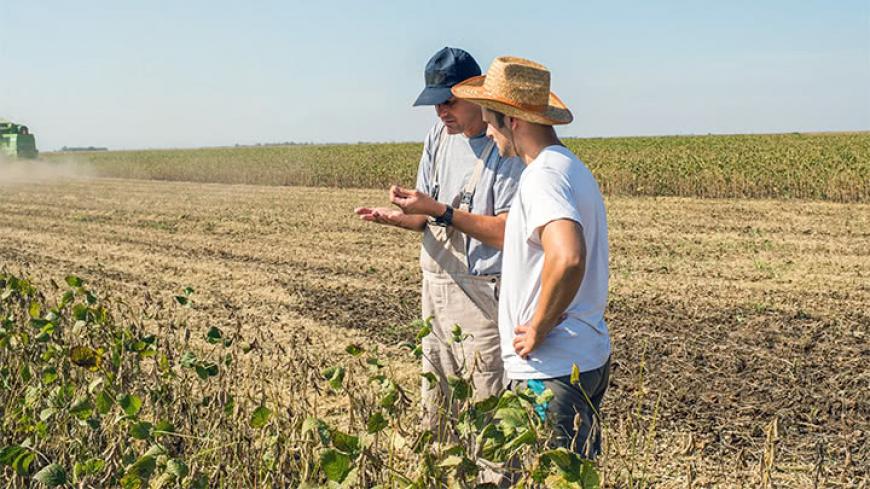Dicamba Complaints in Arkansas Approach 1,000 Mark

Unlike dicamba itself, the dicamba crisis isn’t going anywhere.
Grievances about crop damage caused by the volatile herbicide continue to mount across the country. Hundreds of farmers in at least 21 states have filed complaints alleging that the weed-killer moved onto their properties, harming non-resistant crops and reducing their yields. This could mean tens of thousands of dollars in losses for many farms.
In Arkansas alone, there have been 950 complaints as of August 23. On July 11, Arkansas and Missouri voted to restrict dicamba use for 120 days (the rest of the growing season). Arkansas also increased the maximum fine for herbicide misuse from $1,000 to $25,000, which took effect August 1.

Arkansas governor Asa Hutchinson went on a talking tour earlier this month to speak with farmers about dicamba, among other things. He also created a task force to address the problem, but thus far the task force has not issued any recommendations. It held its second meeting on August 24.
According to Monsanto, half the estimated soybean crops in Arkansas are comprised of dicamba-tolerant soybeans. That amounts to 1.5 million acres. This equal divide among farmers—with many looking out for their own livelihoods perhaps at the expense of their neighbors’—has sparked conflicts and cost at least one man his life.
Half the soybean crops in Arkansas are comprised of dicamba-tolerant soybeans.
Some, though, have no desire to turn their neighbors in, even if they were harmed by dicamba. They are crossing their fingers for insurance money to recover losses from their reduced yields. But they might have more success filing a lawsuit against herbicide producers like Monsanto, DuPont, and BASF.
ClassAction.com attorney Rene Rocha is now pursuing these cases. If you or a loved one suffered a reduced crop yield or other losses as a result of dicamba, contact us today for a free, no-obligation legal consultation. You pay nothing unless we recover for you.
Crisis Not Confined to Arkansas and Missouri
While Arkansas—especially Eastern counties like Mississippi, Crittenden, and Craighead—is considered ground zero for the dicamba crisis, this issue impacts a broad swath of the country, from North Dakota all the way down to Georgia.
Experts estimate that more than three million acres have already been affected by dicamba’s propensity to volatilize and move offsite. And given Monsanto’s statement that there are 18 million acres of dicamba-tolerant soybeans in the U.S., that number will only continue to grow.
Just three weeks prior to the affected area being 3.1 million acres, it was 2.5 million. That’s a nearly 25 percent increase in just a few weeks—making for some scary extrapolations going forward.

Similarly, the total number of national complaints skyrocketed from 1,411 to 2,242—an increase of more than 50 percent. The numbers above are from 13 days ago, which means they have already risen even higher. In Arkansas, for example, the number of complaints has gone up by 74.
At Dakotafest, “the premiere ag event of the Northern Plains,” the question South Dakota State University weed science coordinator Paul O. Johnson got most often was how hard soybeans affected by dicamba would be hit in terms of their yield. Unfortunately, Mr. Johnson had few answers for them, saying, “Trying to predict soybean yield response to observed short-term plant injury symptoms caused by dicamba injury is nearly impossible.”
4,550-Word Instructions Add Vagueness to Volatility
It’s bad enough that Monsanto’s new, supposedly improved formulation of dicamba, XtendiMax, appears to be much more volatile than the company suggested. What’s worse is that it comes with a 4,500-word instruction label that confounds many farmers.
XtendiMax can only be used when winds are blowing between three and 15 miles per hour. It can only be used, at max, 24 inches above the crops. If the temperature rises above 91 degrees Fahrenheit (as it often does in places like Arkansas during the summer), farmers must make adjustments. After spraying dicamba, farmers must wash their equipment three times.
“You have to be a meteorologist to get it exactly right."
With so many detailed instructions, it is easy to imagine someone missing a crucial piece of information—or worse, not reading the instructions because they’re so long. “The restriction on these labels is unlike anything that’s ever been seen before,” Iowa State University agronomy professor Bob Hartzler told Reuters.
“You have to be a meteorologist to get it exactly right,” said Missouri farmer Hunter Rafferty. Monsanto says its instructions are simple enough and that dicamba misuse most likely occurred because farmers didn’t follow the directions. But the more complaints—and lawsuits—that are filed, the less water that explanation holds.


